If you ever dreamed of baking the perfect homemade butter croissants, you’re in the right place. These buttery, golden, flaky butter croissants are a classic French pastry that combines crispy layers with a rich, buttery flavor. Whether you’re serving them for brunch, breakfast or a sweet snack, these croissants are sure to impress your taste buds and your guests.
Making butter croissants from scratch might sound intimidating, but with the right guidance, you can master this iconic recipe. They’re perfect with a cup of coffee or tea and guaranteed to become your new favorite treat.
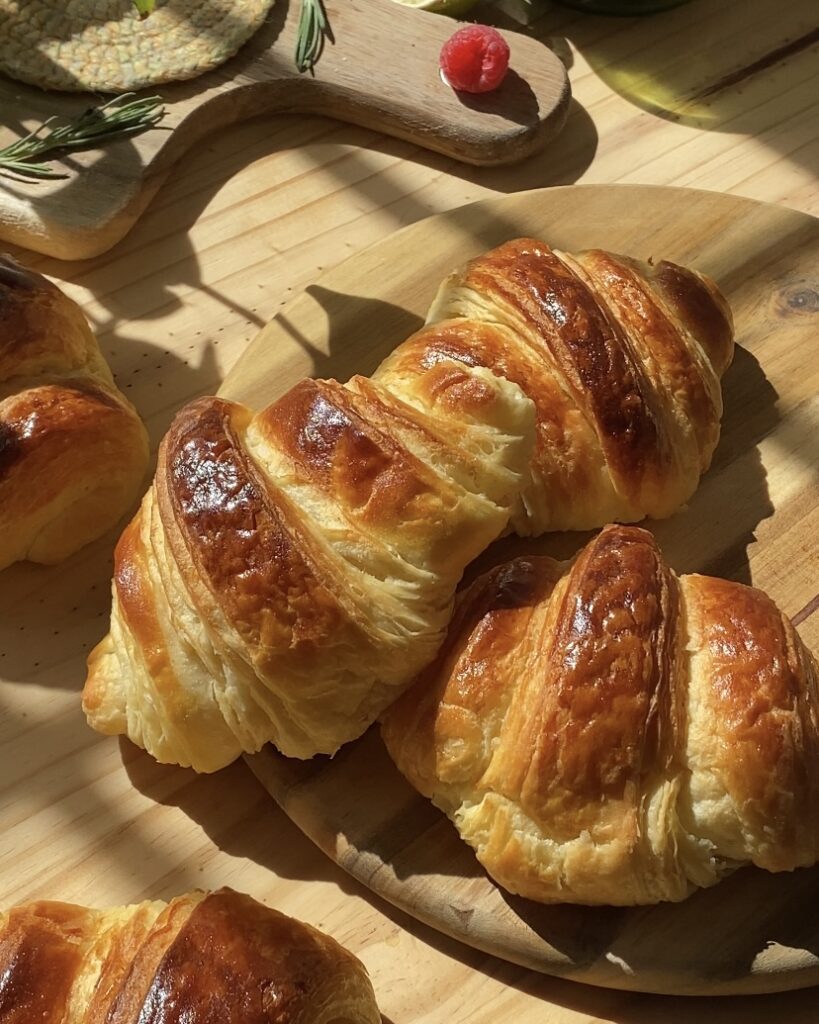

Why butter croissants are the ultimate comfort food?
Butter croissants are much more than just pastries, they’re a symbol of French baking tradition. Their signature layers come from the unique folding and layering technique, which traps butter between the dough, creating their irresistible texture. Every bite is a buttery melt in your mouth experience that is perfect for any time of the day.
With this easy butter croissant recipe, you can enjoy fresh, homemade pastries that are every bit as good as these from your favorite bakery.
why you’ll love this recipe
- Flaky layers, every bite offers perfect buttery flaky layers.
- Homemade Goodness, freshly baked croissants are a treta that can’t be compared to store bought.
- Perfect fr any occasion, these croissants are ideal for parties, tea time or a simple breakfast treat.
Essential equipment for making homemade butter croissants
When preparing homemade butter croissants, having the right equipment can make the process much easier and ensure perfect results.
“BUTTER CROISSANTS RECIPE” EQUIPMENT
- Rolling pin, essential for laminating the dough
- stand mixer with the dough hook
- pastry brush, used to apply egg wash
- baking tray and parchment paper
- Dough scraper or sharp knife.
- food scale or measuring cups and spoons
- mixing bowl, for combining dough ingredients.
The folding process of croissants, creating perfectly buttery layers.
The folding process is a key technique In making traditional French butter croissants. This process is what creates their iconic flaky layers, giving croissants their signature texture and buttery melt in your mouth taste.
When you fold the dough with butter multiple times, layers of butter and dough are trapped between each other, these layers puff up during baking, creating a light, airy and crispy texture we love in fresh croissants.
the basic croissant folding technique ‘the envelope’
Start by preparing your dough and butter block. Take a large block of cold butter and shaping into a square or rectangle. Ensure the butter is well-chilled. Roll the dough into a large rectangle, slightly larger than your butter block, place the chilled butter block on the dough, fold the dough over the butter completely enclosing the butter so it is sealed between the layers of dough.
Begin the rolling process, using a rolling pin, gently roll the dough into a larger even rectangle, avoid pressing too hard to ensure the butter stays evenly distributed.
Once the dough has been rolled out into the desired rectangle size, perform the book fold. Fold the dough in Half horizontally like a book, fold it in half vertically as well to create layers.
chill between folds
After each fold the dough must rest and chil in the refrigerator for least 30 minutes. This ensures the butter remains firm and doesn’t melt into the dough, the layers maintain their integrity, gluten in the dough relaxes
Repeat the rolling and folding process 3 times chilling in between each fold.
process pictures of the folding of this delicious croissant






Proofing croissants, perfectly flaky every time
Place the croissants on a baking Tray, arrange your shaped croissants evenly and cover with plastic wrap to prevent the dough from drying out during the proofing process. Turn off the oven completely and place the covered croissants inside, place a baking tray filled with boiling water on the bottom of rack of the oven. This will create a warm, humid environment.
Allow the croissants to proof for 1h to 1 1h 30 minutes, if the water cools down during the proofing period, replace it with more boiling water.

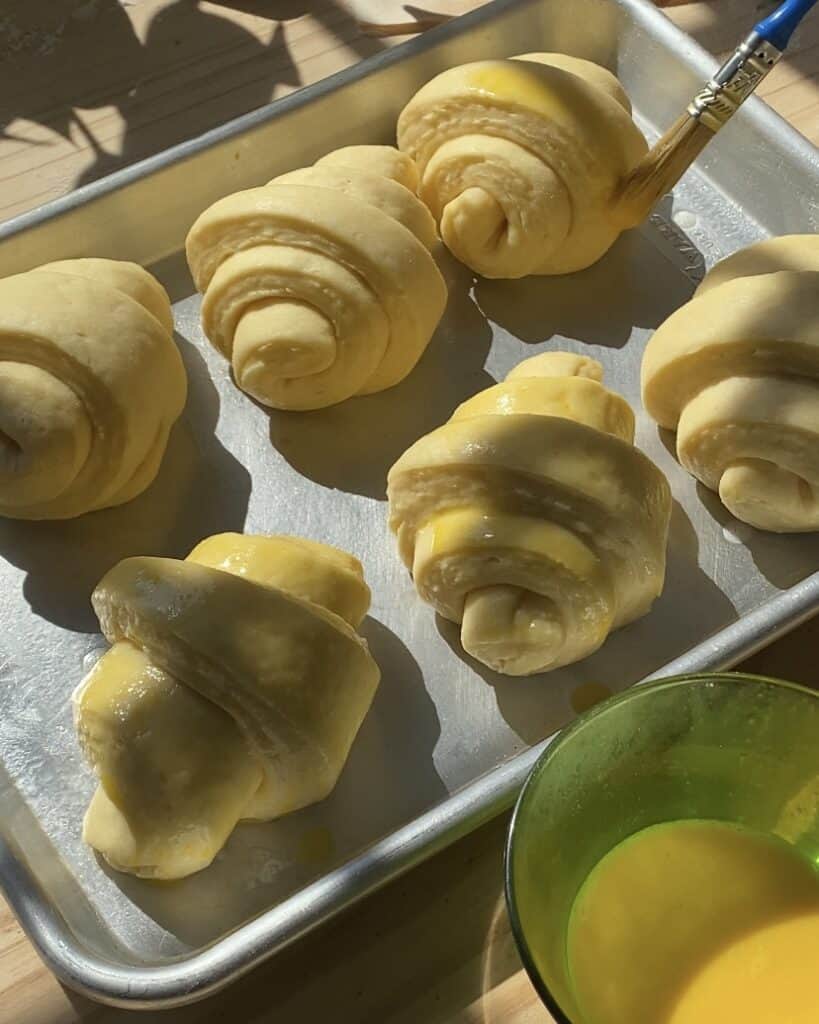
Delicious croissant filling ideas-sweet and savory options
Croissants are incredibly versatile pastries that pair beautifully with a wide variety of fillings.
sweet croissant filling ideas
- Chocolate / Nutella, fill a piping bag with a small round tip with Nutella, use the piping tip to make a small hole in the side or bottom of the croissant. Pipe Nutella into the croissant until it feels slightly full.
- Almond cream, fill the croissants with rich almond cream for a decadent bakery style pastry.
- Berry jam, add your favorite jams like raspberries, strawberry or apricot for a burst of flavor.
- Custard or pastry cream, you can make vanilla, lemon or even coffee custard.
- Fresh fruits and cream, after baking slice your croissants and fill them with whipped cream and fresh berries.


savory croissant filling ideas
- Ham and cheese croissants, add slices of ham and your favorite cheese for a satisfying breakfast or lunch option.
- Egg and bacon, for a hearty and filling breakfast croissant fill with eggs, crispy bacon and some cheddar cheese.
- Smoked salmon and cream cheese, it is the perfect combination and also my favorite. You could add some pesto too.
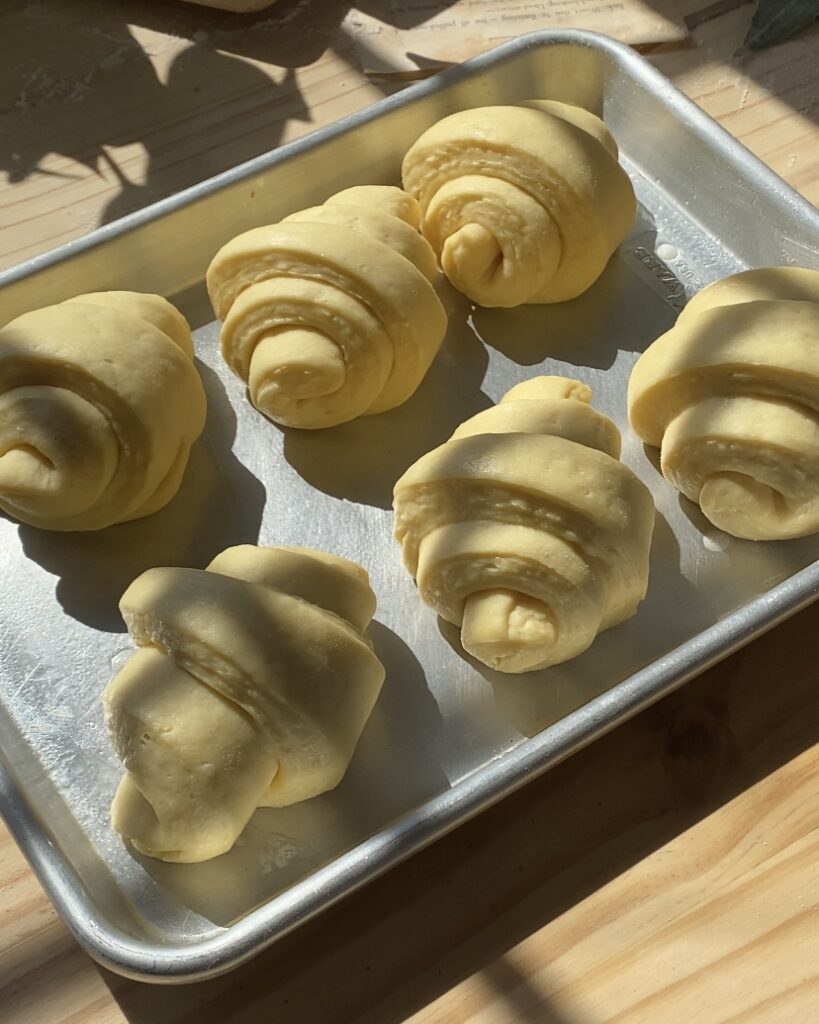
Butter croissant recipe
Recipe in cups and grams. You can find the cup measurements in the printable recipe scrolling down at the end
ingredients
dough
- 250 grams bread flour
- 250 grams all purpose flour
- 7 grams salt
- 90 grams granulated sugar
- 200 ml whole milk
- 1 1/2 egg
- 20 grams butter
- 25 grams fresh yeast
butter block
- 260 grams butter
EGG-WASH
- 1 egg
- 1/2 tablespoon water
more
- boiling water
step by step
1) step one, mix the dry ingredients
Start by preparing the base of your croissant dough, combine all purpose flour and bread flour using a sifter to ensure a smooth texture. Stir in granulated sugar and salt mixing it throughly with a whisk.

2) step two, add the wet ingredients
Use two eggs, if they vary in size (one large and one very small) adjust by using 1 1/2 medium sized eggs. Add the milk and the butter for the dough. Incorporate fresh yeast. If you are baking during summer or in warm environments, hold off on adding the yeast until the last few minutes of kneading to prevent over fermentation.

3) step three, knead the dough
Knead for 20 minutes using a dough hook on a stand mixer at medium speed. If kneading by hand you’ll need to work the dough longer to achieve elasticity. The dough should feel smooth and elastic.

4) step four, prepare the butter block
Roll out the dough to your desired size (check reference images). Shape the butter into a rectangle slightly larger than 1/3 of the dough size. Use parchment paper to help form the butter block evenly.
Keep the butter cold but pliable, do not melt.
5) step five, incorporate the butter
Place the butter on the dough, fold one side of the dough to cover half of the butter, then fold the opposite side to overlap. Pinch the seams and edges to seal the butter inside. Use a rolling pin to gently press from the center outward, keeping the pressure light to avoid breaking the butter later.




6) step six, begin folding
Roll the dough out to its original size and proceed the first fold. Fold the dough like a letter – right side to the middle, left side over the right.
To achieve the classy flaky texture, repeat the same process three times. After each fold wrap the dough in plastic wrap and refrigerate for at least 30 minutes. Always roll the dough in the same direction to maintain alignment.




7) step seven, roll and cut the dough
Once the folding process is complete, roll the dough to a thin rectangle, approximately 45 cm x 20 cm (17.7 in x 7.9 in). Adjust as needed for your desired croissant size. Trim the edges to make them even. Mark the bottom of the dough every 8.5 cm and the top starting at 4.15 cm, making every 8.5 thereafter.
Cut the dough into triangles then, gently stretch each triangle to prepare for shaping.


8) step eight, shape the croissants
Roll each triangle from the base to the tip to create a classic croissant shape. Make sure the tip is tucked underneath to prevent unrolling during baking.


9) step nine, proof the croissants
Proofing allows the croissants to rise and develop their airy texture, place the shaped croissants on a baking tray with enough space for them to expand. Cover with plastic wrap. Create a humid environment by placing a tray of boiling water on the lower rack of your oven, do not turn the oven on. Proof for at least 1 hour or until the croissants have doubled in size.


10) step ten, bake the croissants
Beat one egg with 1/2 a tablespoon of water to create an egg wash. Brush it lightly over the croissants for a golden, glossy finish. Preheat your oven to 220 ºC (428ºF). Bake the croissants for 12 to 15 minutes, or until they are puffed up and golden brown.



Butter croissants recipe
- Yield: 12 Croissants 1x
Description
If you ever dreamed of baking the perfect homemade butter croissants, you’re in the right place. These buttery, golden, flaky butter croissants are a classic French pastry that combines crispy layers with a rich, buttery flavor. Whether you’re serving them for brunch, breakfast or a sweet snack, these croissants are sure to impress your taste buds and your guests
Ingredients
dough
- 250 grams bread flour
- 250 grams all purpose flour
- 7 grams salt
- 90 grams granulated sugar
- 200 ml whole milk
- 1 1/2 egg
- 20 grams butter
- 25 grams fresh yeast
butter block
- 260 grams butter
EGG-WASH
- 1 egg
- 1/2 tablespoon water
more
- boiling water
Instructions
step one, mix the dry ingredients
- Start by preparing the base of your croissant dough, combine all purpose flour and bread flour using a sifter to ensure a smooth texture. Stir in granulated sugar and salt mixing it throughly with a whisk.
step two, add the wet ingredients
- Use two eggs, if they vary in size (one large and one very small) adjust by using 1 1/2 medium sized eggs. Add the milk and the butter for the dough. Incorporate fresh yeast. If you are baking during summer or in warm environments, hold off on adding the yeast until the last few minutes of kneading to prevent over fermentation.
step three, knead the dough
- Knead for 20 minutes using a dough hook on a stand mixer at medium speed. If kneading by hand you’ll need to work the dough longer to achieve elasticity. The dough should feel smooth and elastic.
step four, prepare the butter block
- Roll out the dough to your desired size (check reference images). Shape the butter into a rectangle slightly larger than 1/3 of the dough size. Use parchment paper to help form the butter block evenly.
- Keep the butter cold but pliable, do not melt.
step five, incorporate the butter
- Place the butter on the dough, fold one side of the dough to cover half of the butter, then fold the opposite side to overlap. Pinch the seams and edges to seal the butter inside. Use a rolling pin to gently press from the center outward, keeping the pressure light to avoid breaking the butter later.
step six, begin folding
- Roll the dough out to its original size and proceed the first fold. Fold the dough like a letter – right side to the middle, left side over the right.
- To achieve the classy flaky texture, repeat the same process three times. After each fold wrap the dough in plastic wrap and refrigerate for at least 30 minutes. Always roll the dough in the same direction to maintain alignment.
step seven, roll and cut the dough
- Once the folding process is complete, roll the dough to a thin rectangle, approximately 45 cm x 20 cm (17.7 in x 7.9 in). Adjust as needed for your desired croissant size. Trim the edges to make them even. Mark the bottom of the dough every 8.5 cm and the top starting at 4.15 cm, making every 8.5 thereafter.
- Cut the dough into triangles then, gently stretch each triangle to prepare for shaping.
step eight, shape the croissants
- Roll each triangle from the base to the tip to create a classic croissant shape. Make sure the tip is tucked underneath to prevent unrolling during baking.
step nine, proof the croissants
- Proofing allows the croissants to rise and develop their airy texture, place the shaped croissants on a baking tray with enough space for them to expand. Cover with plastic wrap. Create a humid environment by placing a tray of boiling water on the lower rack of your oven, do not turn the oven on. Proof for at least 1 hour or until the croissants have doubled in size.
step ten, bake the croissants
- Beat one egg with 1/2 a tablespoon of water to create an egg wash. Brush it lightly over the croissants for a golden, glossy finish. Preheat your oven to 220 ºC (428ºF). Bake the croissants for 12 to 15 minutes, or until they are puffed up and golden brown.
Nutrition
- Calories: 463
- Sugar: 17
- Sodium: 404
- Fat: 26
- Saturated Fat: 17
- Carbohydrates: 50
- Fiber: 2
- Protein: 8
- Cholesterol: 86
Archersfood
Recipes from my family to yours
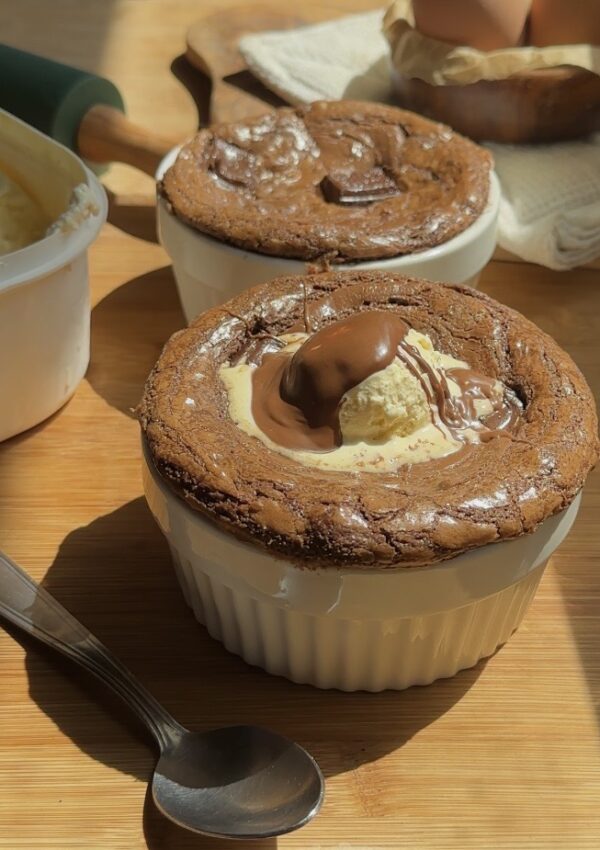
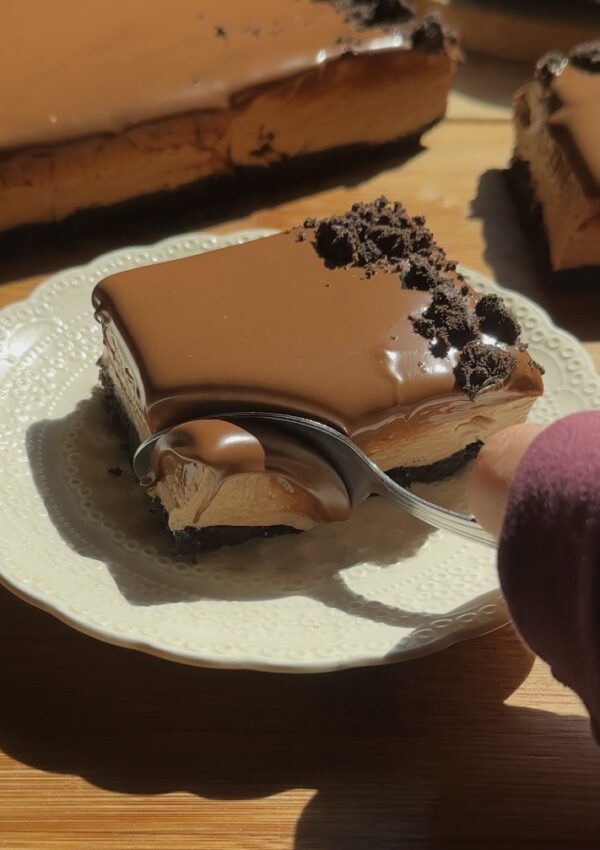


Is there any way to substitute the fresh yeast with instant yeast or active dry yeast? My local store doesn’t sell fresh yeast here.
[…] version of the Normal croissants. Red croissants recipe with video instructions and images to help you make […]